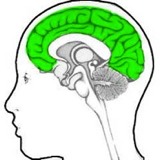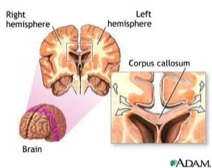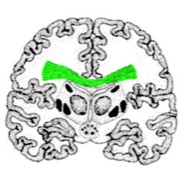NOTE: There are five SUB-SECTIONS in this chapter (do you see them above? Frontal Lobe, Temporal Lobe...). Make sure you open all of them up!
The Cerebrum!
This is the soft cloud-like outer area of the brain that is the majority of the brain’s mass. There are two hemispheres that are separate from each other, but are connected by a central bridge called the corpus callosum (see center right and lower right). This bridge facilitates the communication and processing between the two hemispheres.
Human brains are as uniquely different as faces are from each other. We all do share many common parts with similar functionality, but tiny physical changes make significant differences in personal outcomes.
As with many of the the "higher" ranking mammals on the earth, over millennia our brains grew in size at a rate that was quicker than our skull growth, and therefore our brains now naturally fold up in predictable places, providing more space for neurons to reside. In theory, something that also sets us apart from the other "higher" mammals is our cooking. Because we cook, we have learned how to daily and systematically provide ourselves with proteins and other forms of nutrition at a much faster rate than was possible without cooking. For example, many primates must continue to eat from dawn to dusk, just to survive. In comparison, humans only typically eat 2-3 times a day, taking up perhaps only a couple of hours per day. So the massive amounts of freed up time gave birth to hobbies and more sophisticated collaboration --leading to the birth of real culture and a real need for a much more sophisticated means of communication. As the theory goes, this is why our pre-frontal cortex, and many other places in the brain are so much more developed than our non-cooking primates.
Getting back to our brain folds, or wrinkles... they are also unique per person. However, generally speaking, our major folds are usually found in the expected places. Those main wrinkles are used to divide the brain up into lobes. Although our brains must often incorporate massively complex networks that span the entire brain, these lobes do mark certain key areas of brain functionality. However, it must be stressed that our current ability in defining key areas does not equate to fully understanding the brain, nor does it imply, as several dubious books and corporations capitalize on, that some humans are ‘more left-brained’ because they display certain attributes, and visa-versa.
The brain’s networking system is by far the most intricate system humans know of in the galaxy (really!). The massively convoluted system is used in its entirety all day, everyday. Moreover, cognitive outcomes are context dependent—strongly inclusive of the brain’s past cognitive outcomes. Therefore, it is utterly simplistic to expect to be able to single out single regions of the brain as the causative agents of human actions. Our cognitive outcomes range from chaotic to harmonious brain usage but are always a dynamic context-dependent phenomenon.
In a nutshell: The Cerebral Cortex (see upper right) is the outermost layer of the cerebrum. It is the most important 'human' part of the brain because it is where our most conscious perceptions and thoughts occur. Moreover, the pre-frontal cortex, is the part of the cortex that makes us the most 'human'. (See the "frontal lobe" section in the above links for the juicy details!)
Human brains are as uniquely different as faces are from each other. We all do share many common parts with similar functionality, but tiny physical changes make significant differences in personal outcomes.
As with many of the the "higher" ranking mammals on the earth, over millennia our brains grew in size at a rate that was quicker than our skull growth, and therefore our brains now naturally fold up in predictable places, providing more space for neurons to reside. In theory, something that also sets us apart from the other "higher" mammals is our cooking. Because we cook, we have learned how to daily and systematically provide ourselves with proteins and other forms of nutrition at a much faster rate than was possible without cooking. For example, many primates must continue to eat from dawn to dusk, just to survive. In comparison, humans only typically eat 2-3 times a day, taking up perhaps only a couple of hours per day. So the massive amounts of freed up time gave birth to hobbies and more sophisticated collaboration --leading to the birth of real culture and a real need for a much more sophisticated means of communication. As the theory goes, this is why our pre-frontal cortex, and many other places in the brain are so much more developed than our non-cooking primates.
Getting back to our brain folds, or wrinkles... they are also unique per person. However, generally speaking, our major folds are usually found in the expected places. Those main wrinkles are used to divide the brain up into lobes. Although our brains must often incorporate massively complex networks that span the entire brain, these lobes do mark certain key areas of brain functionality. However, it must be stressed that our current ability in defining key areas does not equate to fully understanding the brain, nor does it imply, as several dubious books and corporations capitalize on, that some humans are ‘more left-brained’ because they display certain attributes, and visa-versa.
The brain’s networking system is by far the most intricate system humans know of in the galaxy (really!). The massively convoluted system is used in its entirety all day, everyday. Moreover, cognitive outcomes are context dependent—strongly inclusive of the brain’s past cognitive outcomes. Therefore, it is utterly simplistic to expect to be able to single out single regions of the brain as the causative agents of human actions. Our cognitive outcomes range from chaotic to harmonious brain usage but are always a dynamic context-dependent phenomenon.
In a nutshell: The Cerebral Cortex (see upper right) is the outermost layer of the cerebrum. It is the most important 'human' part of the brain because it is where our most conscious perceptions and thoughts occur. Moreover, the pre-frontal cortex, is the part of the cortex that makes us the most 'human'. (See the "frontal lobe" section in the above links for the juicy details!)




These video chapters were created as part of H107 (Educational Neuroscience) to provide an introduction to human brain dynamics, by L. Todd Rose, Harvard Graduate School of Education.
